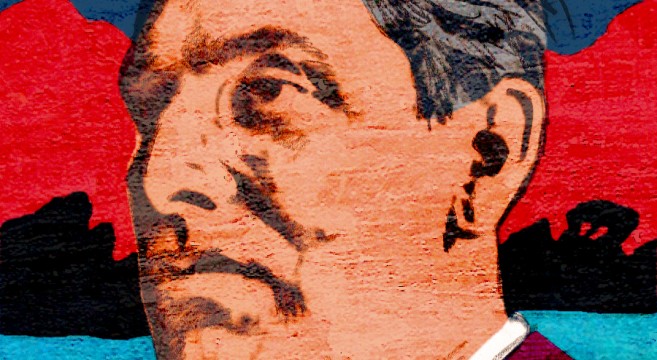
This is a list over Julius Evola’s central works. You could call it a kind of overview of the English translations that are available at the time I write this.
Julius Evola was an Italian writer, living between 1898 and 1974. In all Evola wrote 25 books, plus numerous essays and articles. Below I list the most important Evola books available in English, in order according to the original Italian publishing dates.
. Heathen Imperialism. Thompkins & Cariou, 2007. 147 pages. (Imperialismo pagano, 1928) – A book urging the Italian Fascist regime to conduct an anti-Christian, pagan revolution. Later on, Evola backed down from the more radical opinions in this book.
. The Hermetic Tradition: Symbols and Teachings of the Royal Art. Inner Traditions, Rochester, Vermont, 1995. 240 pages. (La tradizione ermetica nei suoi simboli, nella sua dottrina e nella sua ”arte regia”, 1931) – A book about the spiritual, immaterial meaning of alchemy, like turning your soul into ”gold”, not about melting and refining metals per se.
. Revolt Against the Modern World: Politics, Religion, and Social Order in the Kali Yuga. Inner Traditions, Rochester, Vermont, 1995. 375 pages. (Rivolta contro il mondo moderno, 1934) – A holistic view on man and history, outlining the ancient civilization as anchored in the timeless, transcendent sphere of eternal values and the contrasting modern world as imbued with the temporal, immanent realm of materialism and nihilism. Evola discussed the possibility of a spiritual renaissance to be implemented on a societal level. But at the same time he doubted it, as we see in the last chapter of this very book.
. The Mystery of the Grail: Initiation and Magic in the Quest for the Spirit. Inner Traditions, Rochester, Vermont, 1996. 208 pages. (Il mistero del Graal e la tradizione ghibellina dell’Impero, 1938) – Elaborations of ideas first discussed in Revolt, about the pagan, spiritual nature of the Grail mystery and of the realization of its ideals in the form of the Hohenstaufen empire of the high middle ages.
. The Doctrine of Awakening: The Attainment of Self-Mastery According to the Earliest Buddhist Texts. Inner Traditions, Rochester, Vermont, 1996. 272 pages. (La dottrina del risveglio, 1943) – A book on the original, hardcore form of Buddhism, the teachings of Siddharta Gautama as Evola understood them.
. The Yoga of Power: Tantra, Shakti, and the Secret Way. Inner Traditions, Rochester, Vermont, 1992. 256 pages. (Lo yoga della potenza: saggio sui tantra, 1949) – In the 20’s Evola wrote L’uomo e la potenza (Man and Power) about the Indian practice of dhyâna yoga such as kundalini yoga, the most advanced form of meditation there is. The book is also about tantrism, another esoteric Indian teaching. Overall the book is about freeing yourself of the bonds of indulgence, sloth and fear and instead live a strong life. Evola revised the book in 1949. The Inner Traditions issue from 1992 is based on a revision dated 1968.
. Men Among the Ruins: Post-War Reflections of a Radical Traditionalist. Inner Traditions, Rochester, Vermont, 2002. 328 pages. (Gli uomini e le rovine, 1953) – A book discussing the possibility of creating a traditionally founded regime in Europe, in view of the failure of Fascism and Nazism which had had some of these traits, although Evola had no illusions neither of their inherent traditionalism nor of the current day possibilities for such a spiritual renaissance.
. Introduction to Magic: Rituals and Practical Techniques for the Magus. Inner Traditions, Rochester, Vermont, 2001. 416 pages. (Introduzione alla magia quale scienza dell’Io, 1955) – A collection of articles written in the 30’s by Evola and others of the Ur Group. No author names are given in the 1955 edition.
. Ride the Tiger: A Survival Manual for the Aristocrats of the Soul. Inner Traditions, Rochester, Vermont, 2003. 256 pages (Cavalcare la tigre, 1961) – Evola’s most viable book of ideas, seen from the perspective of the 21st century. No longer hoping for a revival IRL of a traditionalist society Evola adresses how aristocrats of the soul can survive in a time of decay, keeping the spiritual flame burning and being ready to act when Kali Yuga is over and Sat Yuga again dawns. And as Sat Yuga – as some say – started on 11/11 2011 the thoughts in this book are more than revelant today.
. The Path of Cinnabar: An Intellectual Autobiography. Integral Tradition, London, 2009. 287 pages. (Il cammino del cinabro, 1963) – An autobiography of the thoughts, ideas and views Evola had in his life.
. Fascism Viewed from the Right. Arktos, London, 2013. 130 pages. (Il Fascismo. Saggio di una analisi critica dal punto di vista della destra, 1964) – A critical study of Italian Fascism. Evola was never a party member and he was critical of Mussolini’s regime already in the 30’s.
. Meditations on the Peaks: Mountain Climbing as Metaphor for the Spiritual Quest. Inner Traditions, Rochester, Vermont, 1998. 144 pages. (Meditazioni delle Vette, 1974) – A book on mountaineering and its spiritual meaning with references to Nietzsche and Tibetan buddhism, and discussing the mythic and heroic meaning of mountains and interacting with them. Evola himself was a keen climber.
. Metaphysics of War: Battle, Victory and Death in the World of Tradition. Arktos, London 2011. 150 pages. – Contains articles that Evola wrote mainly in the 1930’s and 1940’s about spirituality and solidering, on how traditional societies saw the warrior’s role as something you were intitiated into, not just ”a work to be done” as our current societies tend to see it.
.
Related (in Swedish)
Evola: The Path of Cinnabar (1963)
.
Painting by Julius Evola: ”Paesaggio interiore, apertura del diaframma”, 1920-21










